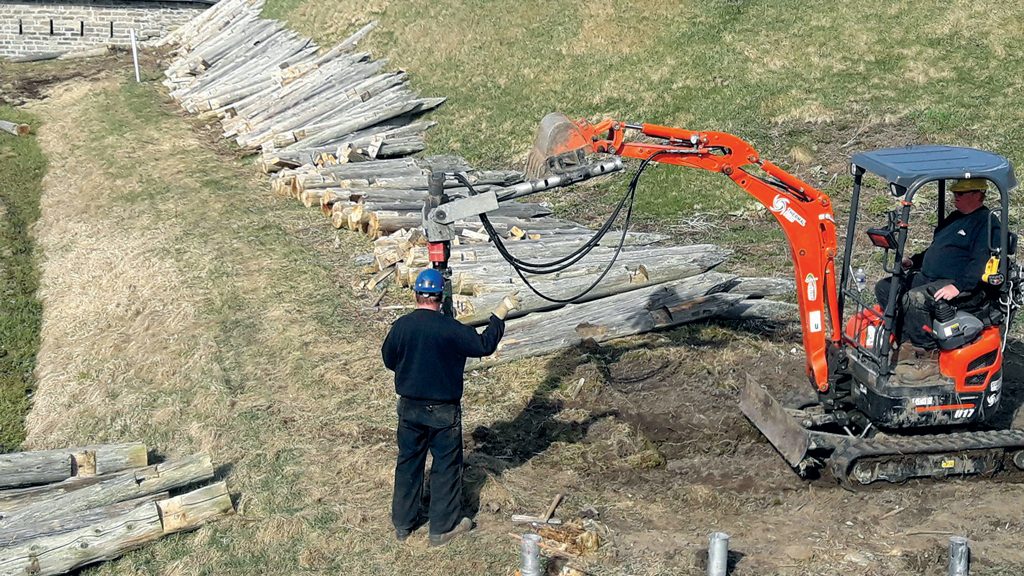The cannon at the Fort Wellington National Historic Site in Prescott, Ont. still keeps watch over the St. Lawrence River.
Thanks to a significant makeover by tradespeople employed by BRC Restoration Inc. its defences — including sharp wooden pikes designed to impale both soldiers and horses — will be ready to pass muster once again.
Built by the British government in 1813, the fort served to defend the line of communications between Montreal and Kingston during the War of 1812.
Troops were assembled at the fort to defeat American forces at Ogdensburg, N.Y. that same year. The fort also served as a defensive installation during the Rebellion of Upper Canada and later served as a military depot during the First World War. It was designated a national historic site in 1923.
The contract with site operator Parks Canada is valued at $2.24 million plus HST. The work includes rehabilitation of Fort Wellington’s fraising (pointed cedar stakes), spiked wooden palisades, wood-and-earthen revetment wall, the carronade (small cannon) platform, masonry arch and entrance gate.

BRC Restoration has fittingly assembled its own army of as many as 18 stonemasons, carpenters, historical restoration experts and experienced labourers to take on the work, which began in March 2018.
While the logs forming the palisades were initially driven into the ground, the new design preserves both strength and historical appearance while promoting longevity of the new construction.
“We’re using historically specified spiked cedar logs 10 to 12 inches in diameter and 10 to 12 feet high,” says BRC Restoration vice-president Arran Brannigan. “But instead of supporting the anchor logs by burying them, we’re driving helical piles every six feet and then welding steel plates to them. We’re then welding HSS posts to the plates and placing cored-out logs over the steel posts. As with the historical design, the remaining logs between the anchor logs are supported by stringers.”
The original sharpened logs used for fraising are buried deep into the side of the steep hill leading up to the fort and protrude at a 180-degree angle.
“If the enemy breached the palisade wall and begin the charge up the hill, they would be greeted by these sharpened logs,” says Brannigan. “The existing logs are probably a couple of hundred years old and are rotting. We’re removing them, excavating around the perimeter of the fort and installing 6,000-pound precast concrete blocks with lengths of HDPE pipe imbedded in them.
“The new cedar logs will be set into the pipe, fastened with collars and then buried at the base. To the eye, the new fraising will perfectly match the historic specs.”
The logs are all locally sourced eastern white cedar milled at Ottawa Cedar Lumber Inc. in Cumberland, just outside of Ottawa. All logs were cored and sharpened to impalement standards by the mill.
“They didn’t bat an eye when we gave them the specifications,” says Brannigan. “For all of us, this is a once-in-a-lifetime project, and everyone was eager to meet the unique requirements of the project.”
BRC also sourced square-headed nails to meet historic project specifications.

The revetment wall, an earthen structure supported by a facing of vertical logs, is also being replaced. However, a new precast concrete retaining wall is being buried to retain the earthen load. It will be refaced by a fresh line-up of cedar logs.
Stonework on the fort’s limestone archway entrance and carronade is being rehabilitated through repointing and resetting of loose stones. BRC is using only historical lime-based mortars to match the original.
Archeologists have already excavated test pits in work areas to determine that they offer a low likelihood of containing historic artifacts. However, an archeologist has been assigned to observe each new excavation.
Fort Wellington is scheduled to be ready to repel invaders once again in spring 2019.











Recent Comments
comments for this post are closed